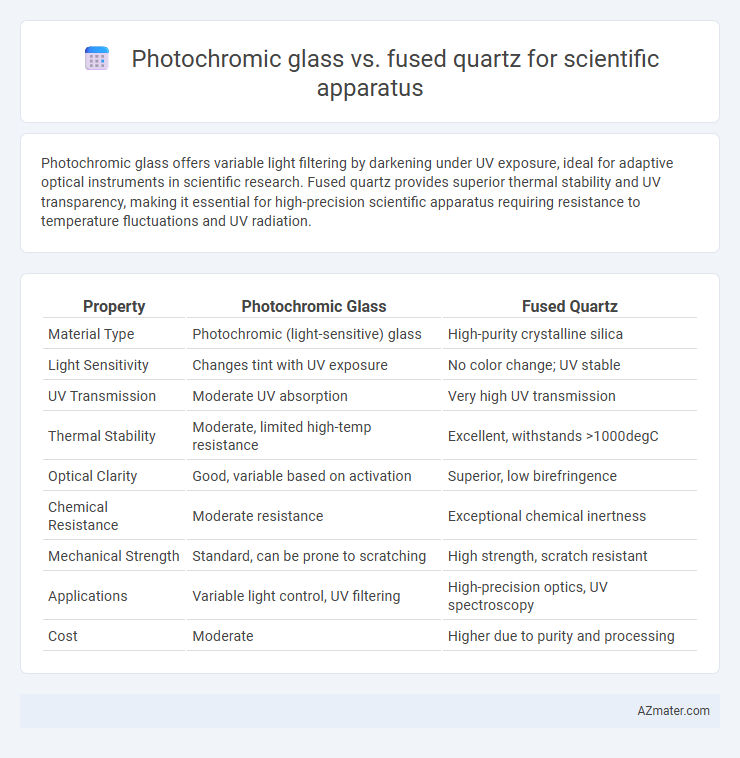Photochromic glass offers variable light filtering by darkening under UV exposure, ideal for adaptive optical instruments in scientific research. Fused quartz provides superior thermal stability and UV transparency, making it essential for high-precision scientific apparatus requiring resistance to temperature fluctuations and UV radiation.
Table of Comparison
| Property | Photochromic Glass | Fused Quartz |
|---|---|---|
| Material Type | Photochromic (light-sensitive) glass | High-purity crystalline silica |
| Light Sensitivity | Changes tint with UV exposure | No color change; UV stable |
| UV Transmission | Moderate UV absorption | Very high UV transmission |
| Thermal Stability | Moderate, limited high-temp resistance | Excellent, withstands >1000degC |
| Optical Clarity | Good, variable based on activation | Superior, low birefringence |
| Chemical Resistance | Moderate resistance | Exceptional chemical inertness |
| Mechanical Strength | Standard, can be prone to scratching | High strength, scratch resistant |
| Applications | Variable light control, UV filtering | High-precision optics, UV spectroscopy |
| Cost | Moderate | Higher due to purity and processing |
Introduction to Optical Materials in Scientific Apparatus
Photochromic glass and fused quartz are essential optical materials used in scientific apparatus, each offering distinct advantages for precision applications. Photochromic glass provides dynamic light modulation by changing its optical properties in response to UV exposure, making it ideal for adaptive optical components. Fused quartz is prized for its exceptional thermal stability, high transmission in the UV to infrared range, and low thermal expansion, making it indispensable in high-precision lenses, windows, and laser components.
Key Properties of Photochromic Glass
Photochromic glass offers dynamic light modulation by darkening when exposed to UV radiation, enhancing user comfort and protecting sensitive instruments from harmful UV rays. Its key properties include reversible color change, high UV resistance, and excellent optical clarity, making it ideal for adaptive scientific apparatus. In contrast, fused quartz excels in thermal stability and chemical inertness but lacks the photo-responsive features crucial for applications requiring variable light transmission.
Unique Features of Fused Quartz
Fused quartz offers exceptional thermal stability and high resistance to thermal shock, making it ideal for scientific apparatus requiring precision under extreme temperature variations. Its remarkable optical clarity and UV transmission surpass that of photochromic glass, ensuring accurate results in spectroscopy and laser applications. Unlike photochromic glass, fused quartz exhibits minimal impurity and high chemical inertness, enhancing durability and performance in harsh laboratory environments.
Optical Clarity and Transmission Comparisons
Photochromic glass and fused quartz differ significantly in optical clarity and transmission for scientific apparatus, with fused quartz offering superior ultraviolet (UV) and visible light transmission up to 95% due to its high purity and low impurity levels. Photochromic glass provides variable transmission by darkening in response to UV light, which can reduce overall optical clarity and consistency in measurement settings. The stable, high clarity and broadband transmission of fused quartz make it ideal for precision optical applications where minimal signal loss and maximal transparency are critical.
UV and Heat Resistance: Glass vs. Quartz
Photochromic glass offers moderate UV protection and heat resistance, making it suitable for general scientific apparatus where light modulation is needed. Fused quartz exhibits superior UV transparency and exceptional heat resistance up to 1200degC, ideal for high-temperature or UV-intensive scientific applications. The choice between photochromic glass and fused quartz hinges on balancing the need for UV filtering with the demand for thermal stability in laboratory environments.
Chemical Durability and Laboratory Safety
Photochromic glass offers moderate chemical durability, making it suitable for environments with mild corrosive agents but less resistant to strong acids and bases compared to fused quartz, which exhibits exceptional chemical inertness and withstands aggressive laboratory chemicals without degradation. Fused quartz's superior chemical resistance ensures minimal contamination risk and prolonged apparatus lifespan, crucial for maintaining laboratory safety and precision during high-temperature or highly reactive experiments. The enhanced stability of fused quartz reduces the likelihood of hazardous glass failure, making it a preferred material for scientific apparatus in stringent chemical and safety conditions.
Thermal Expansion and Stability Factors
Photochromic glass exhibits moderate thermal expansion with coefficients typically around 7-9 x 10^-6/K, offering good dimensional stability under varying temperatures, which is essential for precision scientific apparatus. Fused quartz, with an exceptionally low thermal expansion coefficient near 0.5 x 10^-6/K, provides superior thermal stability and resistance to thermal shock, making it ideal for high-precision optical and laboratory equipment exposed to rapid temperature changes. The choice between photochromic glass and fused quartz hinges on balancing thermal expansion properties with the need for photo-responsive functionality versus extreme thermal stability in scientific applications.
Applications in Research and Industrial Settings
Photochromic glass offers dynamic light modulation ideal for variable lighting conditions in scientific apparatus, enhancing optical precision in spectroscopy and photometry. Fused quartz excels in high-temperature stability and UV transparency, making it indispensable for laser systems, semiconductor manufacturing, and chemical processing instruments. Research applications leverage photochromic properties for adaptive sensors, while fused quartz supports industrial processes demanding thermal resistance and minimal optical distortion.
Cost Effectiveness and Availability
Photochromic glass offers significant cost advantages over fused quartz due to lower raw material and manufacturing expenses, making it more accessible for budget-sensitive scientific apparatus. Fused quartz, while more expensive, provides superior thermal stability and chemical resistance, which is crucial for high-precision applications despite its limited availability. Availability of photochromic glass is generally higher in commercial markets, supporting mass production, whereas fused quartz is often sourced through specialized suppliers, affecting lead times and overall cost-effectiveness in device fabrication.
Choosing the Right Material for Scientific Instruments
Photochromic glass offers dynamic light modulation by darkening under UV exposure, making it ideal for instruments requiring adaptive light control and protection during varying illumination conditions. Fused quartz provides exceptional thermal stability, high UV transparency, and resistance to chemical corrosion, crucial for high-precision scientific apparatus exposed to extreme environments. Selecting the right material involves balancing the need for optical adaptability with durability and spectral performance based on specific experimental requirements.

Infographic: Photochromic glass vs Fused quartz for Scientific apparatus
 azmater.com
azmater.com